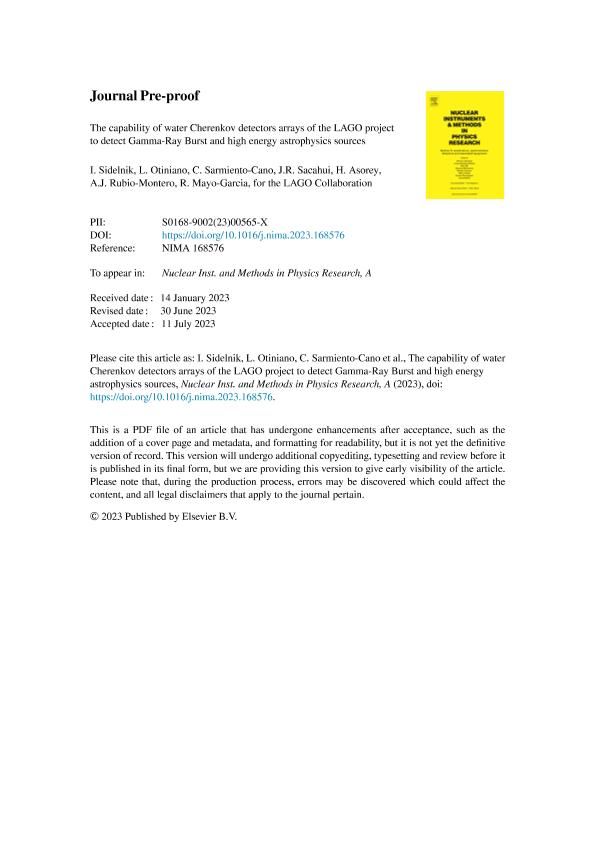Artículo
The capability of water Cherenkov detectors arrays of the LAGO project to detect Gamma-Ray Burst and high energy astrophysics sources
Sidelnik, Iván Pedro ; Otiniano, L.; Sarmiento Cano, C.; Sacahui, J. R.; Asorey, Hernán Gonzalo
; Otiniano, L.; Sarmiento Cano, C.; Sacahui, J. R.; Asorey, Hernán Gonzalo ; Rubio Montero, A. .J.; Mayo Garcia, R.
; Rubio Montero, A. .J.; Mayo Garcia, R.
 ; Otiniano, L.; Sarmiento Cano, C.; Sacahui, J. R.; Asorey, Hernán Gonzalo
; Otiniano, L.; Sarmiento Cano, C.; Sacahui, J. R.; Asorey, Hernán Gonzalo ; Rubio Montero, A. .J.; Mayo Garcia, R.
; Rubio Montero, A. .J.; Mayo Garcia, R.
Fecha de publicación:
07/2023
Editorial:
Elsevier Science
Revista:
Nuclear Instruments and Methods in Physics Research A: Accelerators, Spectrometers, Detectors and Associated Equipament
ISSN:
0168-9002
Idioma:
Inglés
Tipo de recurso:
Artículo publicado
Clasificación temática:
Resumen
Gamma-Ray Bursts (GRBs) are one of the brightest transient events detected, with energies in their prompt phase ranging from keV to GeV. Theoretical models predict emissions at higher energies in the early times of the afterglow emission, and recently GRB190114C was the first GRB detected at TeV energies by the MAGIC experiment. The Latin American Giant Observatory (LAGO) operates a network of water Cherenkov detectors (WCD) at different sites in Latin America. Spanning over different altitudes and geomagnetic rigidity cutoffs, the geographic distribution of the LAGO sites, combined with the new electronics for control, atmospheric sensing, and data acquisition, allows the realization of diverse astrophysics studies at a regional scale. LAGO WCDs located at high altitudes possess good sensitivity to electromagnetic secondary radiation, which is the main expected signature of this kind of high-energy event on the ground. Due to the characteristics of the WCD and the wide field of view, LAGO possesses a large aperture high-duty cycle. In this work, we present the results of the sensitivity of LAGO small arrays of WCDs for the detection of events like GRB190114C. Also, we extend the study to other TeV galactic emitters, such as pulsar wind nebulas, TeV-halos, and some additional sources with unidentified categorizations. These are interesting sources to study taking advantage of the long-term monitoring capabilities of LAGO. We use a dedicated simulation process: ARTI, a toolkit developed by LAGO for high-energy air showers, MEIGA, a framework to simulate the response of the detectors, and oneDataSim, the new high-performance computing and cloud-based implementation of our simulation framework.
Palabras clave:
GAMMA RAY BURST
,
LAGO COLLABORATION
,
WATER CHERENKOV DETECTOR
Archivos asociados
Licencia
Identificadores
Colecciones
Articulos(CCT - PATAGONIA NORTE)
Articulos de CTRO.CIENTIFICO TECNOL.CONICET - PATAGONIA NORTE
Articulos de CTRO.CIENTIFICO TECNOL.CONICET - PATAGONIA NORTE
Citación
Sidelnik, Iván Pedro; Otiniano, L.; Sarmiento Cano, C.; Sacahui, J. R.; Asorey, Hernán Gonzalo; et al.; The capability of water Cherenkov detectors arrays of the LAGO project to detect Gamma-Ray Burst and high energy astrophysics sources; Elsevier Science; Nuclear Instruments and Methods in Physics Research A: Accelerators, Spectrometers, Detectors and Associated Equipament; 1056; 7-2023; 1-5
Compartir
Altmétricas



